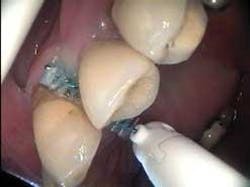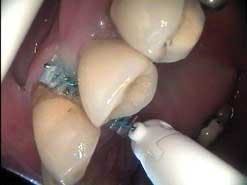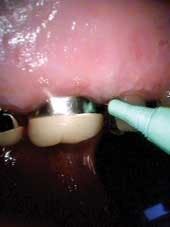Got to Go-Betweens it
by Karen Kaiser
Summer camp was always a high point in July when I was a young girl. At camp, among the various activities, hiking excursions were particularly enjoyable. Hiking miles from our camp site led us to many adventures or natural wonders. Each year, every camper longed to trek to favorite locations.
One remote spot, aptly named "Fat Man's Misery," was forever a hiking highlight. This marvel of nature was created by two enormous slabs of flattened stone that remained within feet of each other as they sloped upwards. The challenge for the young camper was to muster the courage to shimmy between the flat, rocky formations and wiggle your way courageously to the top. When you were wedged within the confines of the crevice, the only light came streaming in from the sky as you looked upward. The rocks were damp and dripped with condensation. Emerald moss provided slick areas for footing as you slowly squeezed through. Many campers' minds had the same thought as they passed through the narrow fissure: "What if the rocks shift and squish me?" or "What if I get stuck?"
Confined spaces remain a predicament that many home-care campers encounter as they attempt to maneuver floss and threader under fixed bridgework or between embrasure spaces.
Motivating patients to perform daily plaque-removal duties under bridgework can seem quite challenging, especially when they might feel that brushing alone may perhaps be all that is needed. Even when the dexterity is present for using adjunctive interproximal tools, the mindset of regular bacterial agitation can somehow slip through the cracks. Brushing alone only removes half of the plaque — hygienists are faced with inventing clever ways to help patients remove the other half. (The dismal statistics on interproximal compliance are not surprising.)
Recommending home-care tools, such as Sunstar Butler's Go-Betweens® Cleaners or Proxabrush Snap Ons®, makes it easier to address compliance issues. When patients are offered an alternative to floss, successful under-the-pontic care can be bridged with these additions. Indications chairside for introducing interproximal brushes would be embrasure spaces (healthy/ unhealthy) and under fixed bridgework, implants, and orthodontics.
Guarding bridges, especially at the margins, is important. The small cylindrical shape of the Go-Betweens brush is designed to shimmy into interdental spaces as small as 0.8mm. The filaments on the necks are positioned under the bridge, and using a back-and-forth (gentle) motion encourages firmer gingival tissue with regular use.
When tissues are not manually stimulated, the result will be tender, swollen areas that bleed from biofilm breakdown. The bacteria must be "stirred up" so colonization remains difficult. Bacterial debris left to rot at the junction of root and restoration will end up costing the patient top dollar for replacement because they neglected the area.
The brushes of the Go-Betweens and Snap Ons interproximal brushes are impregnated with chlorhexidine — a decontaminating measure to slow the growth of bacteria on bristles in between uses for up to 14 days. For patients' home use of this tool, have them dip the bristles in Listerine® or chlorhexidine during use. Instruct your patients to use the bristles to deliver the antibacterial agent directly under bridgework and directly (contact killing) on the bacteria-boggy embrasures. ACT fluoride rinse and professionally dispensed remineralizing fluorides can also be delivered in this direct fashion. Fluorides provide antibacterial and decay protection along with sensitivity relief in compromised areas. Again, douse the tapered filaments and gently coat exposed root surfaces and any vulnerable margins.
The cylindrical heads of the Snap Ons are perfect for implant maintenance. Patients will not scratch dental implants using these nylon filament brushes because the wire substructure is also coated with nylon, a non-scratching plastic. This nylon coating avoids the possibility for galvanic sensitivity by avoiding metal on metal contact when the tool is in motion.
Interproximal brushes are a mainstay for orthodontic hardware maintanence. These brushes can be used during the recare to clean debris from brackets and then dispensed complete with professional instruction. Consider including interproximal brushes in orthodontic kits dispensed from your office.
For patients with dexterity challenges, the interproximal travel brushes do not require assembly. Caregivers rely on the ease of interproximal brushes for patients who are physically or mentally unable to perform self-care. Patients with arthritic conditions or who are frustrated with floss will be motivated to improve embrasure cleaning with an easy to use supplemental brush.
Recently, the Go-Betweens Angle has entered the market. The Go-betweens Angle allows for improved ergonomic intimacy with tooth and tissue. The Angle is also coated with an antibacterial agent. The maneuverability of the Go-Betweens Angle, with a tapered filament, promotes compliance by refining the neck design.
A grin from your patient's face is earned when you solve the bridge maintenance issues he or she have been struggling with.
Patients may comment, "This area has always been tender and constantly bleeds." These patients are in need of a measure to correct the issue. Regrettably, some patients are not overly concerned with hemorrhage because, for as long as they can remember, the area has been bleeding. This situation warrants the expertise of the hygienist to revisit the home compliance issue and introduce supportive home-care tools. When an un-maintained fixed bridge is left to fend off oral elements without any stimulation, the resulting tissues will look much like freshly ground meat under the bridge. Encourage your patients and help them "beef" up the neglected area through chairside education using a take-home interproximal tool.
Aversions towards interproximal cleaning range from non-compliance and lack of knowledge for desired care levels to dilemmas regarding dexterity. Through professional guidance, most of these barriers can be abolished. Patients may be unaware of the ease offered by interdental devices and believed they were forever sentenced to blue-fingered flossing. When you find your patients' embrasure cleaning is caught somewhere between a rock and a hard space, offer easy ways to gain interproximal compliance and achieve home-care objectives through the use of interdental brushes.
For more information on these products, visit www.jbutler.com or ask your local Sunstar/Butler representative for product information and professional samples.
The author did not receive compensation from Sunstar/Butler for endorsement and publication.
Karen Kaiser, RDH, graduated from St. Louis' Forest Park dental hygiene program in 1994 and currently practices at the Center for Contemporary Dentistry in Columbia, Ill. She has written several articles for RDH and other publications, sits on dental hygiene panels, and presents seminars. She can be contacted at hygiene [email protected].


